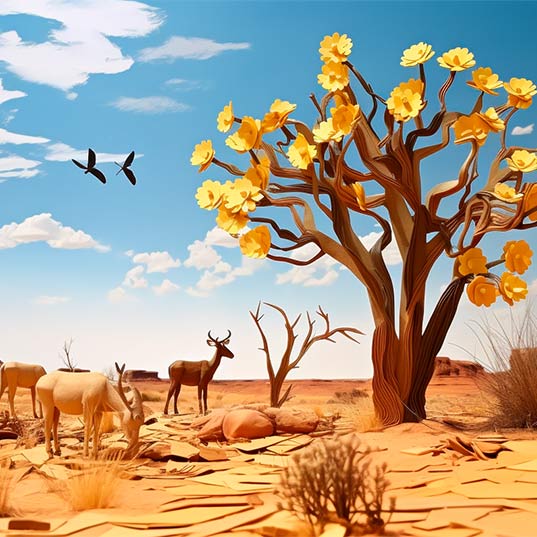World Environment Day: Regenerative agriculture to ensure a sustainable future
Former Rugby player David Pocock talks about sustainable ways of managing land as part of the solution for the climate crisis and the loss of biodiversity.
In 2008 I started work on a community development project in a rural part of the country of my childhood - Zimbabwe. We were working on food and water security, maternal health and education. Things in this part of Zimbabwe - in many parts of Zimbabwe - were tough. We spent a lot of time working with subsistence farmers who were struggling to grow enough food to feed their families and generate income to pay for healthcare and school fees. Our work tried to help alleviate some of this pressure but over time I began to wonder more and more about the causes of poverty in these communities. One of the glaringly obvious things was the state of the land.
Much of southern Zimbabwe is made up of rangelands, that is ‘dry open country’ — grasslands, scrublands, woodlands and semi-desert. They are primarily used for grazing by domestic animals or wildlife, and a huge number of people depend on them. In Africa alone rangelands feed over 55% of the continent’s livestock and directly sustain more than 268 million people. They also play a critical role in maintaining biodiversity, providing habitat for much of the world’s wildlife populations. ⠀
⠀
Despite their importance, 75% of Earth’s rangelands are degraded. Without major changes to how we manage them, we’re on track to see 90% degraded by 2050. If we do not restore our rangelands millions of vulnerable people will find themselves much worse off. Continued land degradation will accelerate climate change, which is a leading driver of biodiversity loss. We must restore rangelands for the sake of people and wildlife.
It can sound a bit vague to talk about - especially if you don’t live near rangelands - so to give you a better idea of what this means, when rangelands are degraded (usually through overgrazing), soil develops a hard crust which water can't penetrate - that's bad for vegetation and waterholes. Plus, without grasses and plants anchoring the soil, run-off from heavy rainfall pulls topsoil into streams and rivers, leading to worse water quality and massive gully erosion over time.
 Healthy rangelands, on the other hand, absorb rainfall, reduce run-off, support plant life and restore a number of cycles that are crucial for ecosystems to thrive.
Healthy rangelands, on the other hand, absorb rainfall, reduce run-off, support plant life and restore a number of cycles that are crucial for ecosystems to thrive.
This might sound like a niche problem for Zimbabwe but rangelands cover almost 70% of the Earth’s landmass so that’s a huge chunk of land that’s degraded and in need of restoration. Thankfully, once I started looking into it I soon learned that there are so many incredible people working to solve it.
People in places like Ol Pejeta in Kenya—which I was lucky enough to visit after the Rugby World Cup in 2015. Ol Pejeta is a 110,000-acre wildlife conservancy with lion, rhino, elephant and over 6,000 cattle—they have the largest herd of Boran cattle (a locally adapted breed) in the world. The cattle are used as a management tool to regenerate the grasslands, which benefits all the wildlife—from those who eat the grass to those who eat the animals who eat the grass. They also provide an income, through the sale of meat and Boran genetics, to help the conservancy cover its costs.
Cattle are vital to the livelihoods of many rural communities but are often viewed as a threat to rangeland health. Overgrazing can lead to decreased rainfall effectiveness which leads to increased drought, food insecurity, and wildlife decline. But regenerative cattle farming uses planned grazing and kraaling practises (mobile fenced areas where all the cattle spend the night) so that cattle help rangelands recover and thrive!
Local communities have a long tradition of cattle ownership in Zimbabwe and on many of the world’s rangelands. The economic impact of drought and the global health crisis means cattle are very important to the livelihoods of rural families. In this kind of regenerative farming they can, with the right knowledge, skills and resources, become a valuable part of restoring rangelands providing food, income and also restoring ecosystems for wildlife.
It’s not only in parts of Africa that Holistic Management and what is now being called ‘regenerative agriculture’ is useful. Here in Australia, there is a growing regenerative agriculture movement led by farmers like Charles Massy, Peter Andrews, Vince Heffernan, Colin Seis and many others. These farmers are managing holistically and utilising management tools to farm in a way that produces healthy food and healthy landscapes.
My hope is that the knowledge we’re building about how to manage degraded land will help contribute to solving the two major crises we face - climate breakdown and a loss of biodiversity at a rate that has not been seen since the dinosaurs went extinct. We must begin to consider how we can better care for the land that sustains us.







